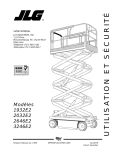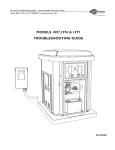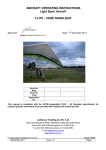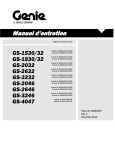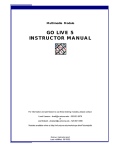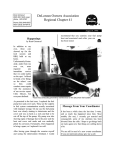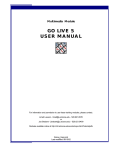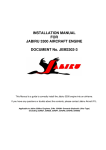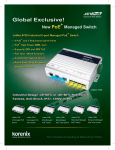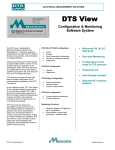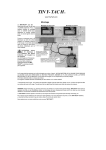Download RECOMMENDATIONS 9.9 PROBLEMS / RECOMMENDATIONS
Transcript
Comments extracted from PDQ form:9.9 engines Re-organized & Summarized by Ed Ellis (Tranquility - hull #18) edwinellis@c harter.net RECOMMENDATIONS PDQ 36 Owners manual http://www.pdqyachts.com/ver2/pdfs/theCats/PDQ36Manual.pdf RECOMMENDED SPARE PARTS for Yamaha 9.9 Oil gage cap/plug Plastic oil drain plug Stator CDI Control cables Shop manual Oil pump Fuel pump woodruff keys for the flywheel 20-micron spin-on fuel filters 5-micron Racor water separators. Recommended parts places Boats.net ß appears to be the cheapest BOATTUNE.com (1-888-324-8348). Seaway Marine (Canada). Call Kumar 905-721-2121 Mechanics Benjamin from Exuma Dive Shop Re-bushing props Frank and Jimmy's prop Shop in Ft. Lauderdale. 800 228-6077 - Bob Lux Bob@fjpropcom 200 S.W. 6th St, Ft Lauderdale, FL 33301 Trapper Marine on Marco Island Florida. 9.9 PROBLEMS / RECOMMENDATIONS Starter problems PROBLEM: Our port engine starter is not engaging the flywheel. The problem started originally with no power to the motor due to worn-through power cables. I have soldered them (as a temporary fix while my new cables are delivered), but I can't get the starter to engage. Upon turning the key, the starter wheel spins, but the teeth don't lift to engage the flywheel. Does this mean my starter has gone bad or could it be my wiring? Any help is appreciated If I recall, the centre part pops up. Try lubricant and if that does not work you may have to rebuild. …the service manual indicates that the cause is most often a corroded or gummed up bendix. They suggest disassembly, cleaning and lubrication. According to the assembly illustration there is a keeper ring at the end of the shaft that can be removed to allow the other parts to come off the shaft …we had the problem of the starter gear "popping up." Someone more knowledgeable suggested reversing the battery wires. Voila! a quick fix. So, pull the starter cable to see the direction of turn appropriate for the starter. If it is not what your starter is turning, reverse the cables. Since my problem started when the wire harness chaffed through completely, it is possible that the starter is spinning in the wrong direction. I am in the process of replacing the wiring harness, then tackle the starter, (I have already lubricated the bendix). Starter problem is fixed. After installing the new wire harness & lubricated the "shaft" & bendix of the starter, she fired right up. It seems the problem was with the wiring harness. At first the starter wasn't getting the proper amount of power, then as the wire harness chaffed through more, no power was being supplied to the engine (even after temporarily soldering the cable). In addition to the black cable wraps, which were also chaffed through, I've installed extra chafe protection to the area where the harness rubs against the motor carrying handle. Tilt lock (a.k.a.tilt lever) Problems Comments extracted from PDQ form:9.9 engines Re-organized & Summarized by Ed Ellis (Tranquility - hull #18) edwinellis@c harter.net PROBLEM: The starboard engine kicks up in reverse because the tilt lock lever does not engage. And of course when it does it wraps the engine lift cord around the prop! In an older thread on this topic it was recommended that the tilt lock be moved to the right or left. Mine doesn't budge. One of my tilt locks was temperamental for a while. It required a combination of lubrication and bending to restore the shape (it had been bent to one side a bit) after which it worked fine. Frozen tilt locks are a common problem on the 9.9 Yamaha. I have had some short term success using copious amounts of WD40 sprayed on the mechanism under the lock lever but the only real fix is to pull the engine, disassemble, and lubricate the whole system (which can be a real challenge!) On Catnap when an engine pops up in reverse, I tighten the engine clamps on that engine, and the problem stops. …gave up and rigged a simple strap arrangement that's easy to use. Both of my engines have been damaged over the years because of the hold down not working properly. PROBLEM: The tilting lock handle on one of my engines is frozen in place. I've sprayed it with penetrating oil & WD-40 to no avail. Will grease in the tilt tube fitting help my situation? I've had to lash down the engine to keep it from kicking up when I'm in reverse. I greased the tilt tube and some of the grease escaped onto the spring. I also sprayed the entire spring with a Teflon lube and began slowly working it back and forth. After a while the range of movement was extended to where it was functioning again. I still could not get it to have the free movement of my newer engines. I think the nylon parts get compressed or swell after time binding the lever. You may have to remove the whole works and replace the bad parts. Hope NOT!! PROBLEM: Is a special adapter needed to apply grease to the fittings on the tilt tube? My grease gun will not fit inside the recess around the zerk fitting. Use a needlepoint adapter from NAPA... part # 715-1215. It is a needle nose adapter that fits on your grease gun. Place the point in the hole in the zerk fitting. You will need a small grease gun or a flex hose to be able to get to the fitting. Outboard engine lanyard and reverse PROBLEM: I have cut the engine raising lanyard (and spun the hub) twice now by shifting to reverse. I'm guessing the mechanical reverse latch is letting the engine rise too much, creating the slack which gets sucked into the prop at the absolute least opportune time. HELP! Every time I drop my engines I pull hard on the lanyard to be sure the engine is locked down. If not, I open the locker and manually push it down. You should hear a click when the lock engages. You may need to grease the pivot shaft. The lock spring also may need greasing so it will engage automatically when dropping the engine. You also might try shortening the lanyard so only the exact amount of rope you need is on the engine side of the 'hole'. This is done by lowering the engine, then making the 'stopper knot' come right to where the rope goes down into the 'hole' The lock tab on the Yamahas slides port and starboard. In one position they will lock the engine down, in the other they will not. I cannot remember which direction is lock and which is unlock. Listen for the locking click, if you do not hear it slide the locking tab port or starboard. Dilemma resolved. The engine mount clamps weren't tight enough. The engine was rotating up from the mounting board in the well. DOH. If I'd followed advice and really given it a tug after lowering the engine, I would have saved myself a swim. I always check to see that the engine is locked down when lowering the Yamaha 9.9. Also I tie a not in the line so it is tight when down. Also check the line pulley on the lower end of the engine. It should not be a swivel pulley but rather fixed so it will not swivel. This stops the line from rapping on itself. I have had my PDQ for 12 years and using this procedure am still using the original engine lowering line on one of my engines. Control Cables I am replacing the throttle and shift cables on Tanah Keeta (Hull # 36089). For anyone interested, the lengths are 10 ft and 14 ft Comments extracted from PDQ form:9.9 engines Re-organized & Summarized by Ed Ellis (Tranquility - hull #18) edwinellis@c harter.net …Not sure if it matters, but hull 36041 has 13' and 9' cables respectively. I have had to replace all 4 of them in the last 2 years. 14' and 10' might work as well or perhaps somewhere in the production line they changed sizes? …If you need to replace the bracket that connects the cables to the engines, this is a Yamaha part and can be purchased thru Boats.net. Their web site is very helpful and has schematics with part numbers for all assemblies for the Yamaha 9.9 ( and any other Yamaha engine) The plastic connectors that actually connect to the shift and throttle levers have a thread size of 10-32... the same as on the Teleflex 3300 control cables. …have ordered the Teleflex TF Xtreme 3300cc cables. They are more expensive but offer improved performance over the standard Teleflex models. Also, by ordering them from Shoreway in NJ, I saved about $25 per cable versus West Marine. PROBLEM: My shift linkage jammed and would not allow the shift lever to move. I mistakenly started at the shift lever to investigate the problem. After removing the entire shift mechanism, I determined the problem to be at the motor. The end of the control cable is composed of two sleeves and the inner one had corroded and was jammed in the outer one. After removing the cables from the motor I could twist the sleeves and release the jam and then grease them to restore movement. All of this could have been prevented if I had greased these on a frequent basis. I also broke the neutral start switch in the shift mechanism when I pulled the shift levers from the mount.... Anyone have an idea where I can get a replacement? I found a supplier that stocks all sizes of cables for the Morse-Teleflex control sets. They also were able to supply the neutral detent switch. If you need to replace anything on your shift controls, try Shoreway Marine. 1 800 443-5408. I by-passed my bad neutral switch, just to get my engine started, and never put in a new one. I got the replacement switch from my local Yamaha dealer. What type of grease do you recommend using on the cables? Any marine grease should be adequate. PROBLEM: For those of you that have replaced them before they broke, can you salvage the original cables to use as emergency spares? Or does the process of removing them for replacement render the original cables bent, broken and useless? I've replaced the cables on my #43 36' twice and have found that they seem to kink right at the engine. I fabricated a bracket that prevents the kinking at that point. I also noticed that the holes that the cables are fed through from inside the boat is too far aft and the cables do not have enough slack to allow an easy bend. Might want to try redrilling those holes and moving them as far forward as possible in the motor nacell .Re: keeping the old ones, with all the trouble to replace them, I don't think it's worth it. Why bother? It’s like keeping an old pair of socks with holes in the heels! A new spare set is cheap I have replaced two sets so far on Allezcat. The first time I used Yamaha brand and the second time Teleflex/Morse Red-jacket. Both are still going strong. I carry one replacement set. The cables to the port engine (on the 36) are longer by about 3ft so the spare set is sized to reach the port engine. It is a relatively easy change on my boat. Both breaks occurred at the engine shift attach point from the flexing during engine tilt The cables usually don't break, they just become stiff and hard to operate. If you think that you will need spares, you are probably better off with new ones, given the difficulty in replacing them. I have found the Yamaha brand cables to be the best, by far On my PDQ 32 they came out usable. As I took them out I attached a piece of string to help snake the new ones back. It was not easy. 9.9 Yamaha Trouble shooting PROBLEM: One of my engines will not start. The engine was running perfectly two days ago. Now when there is absolutely no effect when turning the key to the start position. The fuse on the engine looks good and I can measure 13.8 volts at the starter solenoid. Does anyone have a most likely problem? I guess I'll start replacing the cheapest item and keep going till I find the problem. Comments extracted from PDQ form:9.9 engines Re-organized & Summarized by Ed Ellis (Tranquility - hull #18) edwinellis@c harter.net …we finally pinpointed the problem as loose connections in the cabinet under the throttle bodies. They had vibrated loose. We reconnected them and they started right up …similar problem. We also had voltage at the starter. It turned out to be a corroded connection of the battery wire at the circuit breaker, which in his boat was mounted in the engine well, a most corrosive environment. You might also check connections at the start solenoid or the solenoid itself …need to check for voltage on the small wire which goes to solenoid from the key. if while turning the key you get no voltage there, then you need to back up the starter circuit. if you do it's in connection to solenoid or solenoid/ starter, etc. … It was the spade terminal in throttle quadrant falling off its start in gear switch. 9.9 cooling intake PROBLEM: engine has lost its cooling stream. When you hold your hand in front of the pee hole you feel an air stream so it seems the pump is working. I discovered the problem late yesterday and checked for blockages in the plumbing at engine level but I did not get a chance to get under the boat and check the water intake for blockage. Can someone tell me what I will find at the lower end? Is there a removable intake screen? The Yamaha 9.9 has two plastic intake screens located on each side of the lower unit just below the anti-cavitation plate. Suggest you pull the hose off the plastic discharge fitting first and run the engine to check for water flow from the hose. …probably install a new impeller after haul out this fall. Be sure to check your thermostat too. 9.9 sputters and dies above 1/2 throttle PROBLEM: Already changed the carb and ruled that out. Thinking it must be electrical Problem: start engine just fine, warm it up. When I give it power it spits and sputters before running up. Under load it will only achieve half power even when given full throttle. It also does this sporadically. After changing carb, it ran twice with out a problem, following morning it would not run up to power. If I kept it up, it eventually stalled …I had pondered that oil pressure and or a heat/wiring related problem also because that can also shut you down. I will see if there is a way to test them, again thanks …I have heard that there is an automatic slow down for low oil pressure and that changing the oil strainer will improve the pressure. It may be the oil pressure sensor going bad. I am having a similar problem intermittently. …Have you checked the anti-siphon valves? I had a lot of problems until I removed them. Try running from a remote tank to determine if there is an obstruction in the fuel line. I had a problem where the inner wall of the fuel line separated & was blocking the flow PROBLEM: Prior to launching, I had the valves adjusted by my mechanic. Fuel is from last year, only about 5 gallons in the tank, with fuel stabilizer. - Everything OK, ran with both engines at about 2800 rpm. - 30 minutes into the trip, switched to only the port engine, ran for 1 hour at 2800 rpm. - Switched to only the starboard engine ran for 15 minutes at 2800 rpm, until ... it sputtered and died. Restarted, idled fine. As soon as I revved it above 2000 rpm, it died. Tried a few times, same thing. Ran with both engines at 2000 rpm for a few minutes, then revved them both to 2800, starboard engine came up on the 3rd try revving it. Ran 1.5 hours, both engines at 2800 rpm, reached Chicago, and throttled both down to idle to enter the harbor. Revved them back up and starboard engine died. Each time I would rev the starboard engine past 2000 rpm, it would die. Got into the slip OK. Tried revving the starboard engine past 2000 rpm in neutral, many tries, as I felt it would die so I brought it back down to idle. Finally got it up to 3700 rpm and ran it for about 10 seconds (hoping to get crud out of the engine, if that was the Comments extracted from PDQ form:9.9 engines Re-organized & Summarized by Ed Ellis (Tranquility - hull #18) edwinellis@c harter.net problem). My first thought would be bad fuel, but if this was the case, wouldn't I have problems with both engines? And if crud is in my 9 year old fuel tank, how can I clean it out? …never store the boat with less than full fuel tank. I did and had terrible problems until I had it pumped out. You might look at the accelerator pump on the bottom of the carb. It has a diaphragm and a spring but just above that spring in the body of the carb is another spring and ball check valve. Clean it out good and use compressed air to blow it out. My engine would run but not over 3700 RPM. I am guessing your problem is fuel and you now have some water/contaminant in the carb...... although it normally affects the idle first. You also need to install serious filters if you haven't already. I now have 20 micron spin-ons and am going to add 5 micron Racor separators. It is also good to use Stabil in every tank... it helps remove varnish in addition to the storage attributes. I think you might be right that it is water in the fuel/engine. I'll do the cleaning you suggested. PROBLEM: What do you suggest as the best way to get the water out of the fuel tank on the 32? You can either add gas line antifreeze or denatured alcohol. Both chemicals do the same thing because they are the same thing. They mix with the water (alcohol will mix with water of course, otherwise no boat drinks!). Then the alcohol and water mix run through the engine and get burned off. I'd do this three or four times just to be sure. Most important tips: Stabilize if leaving fuel in the tank for a winter haul or storage. ALWAYS keep a bottle or three of stabilizer aboard. If leaving the boat for a long time, fill tank completely to prevent condensation which leaves water in the fuel. If in a warm climate, add a biocide to prevent growth in the tank. One last tip... if you have aluminum tanks, check to be sure that they are not mounted on rubber pads. Rubber contains carbon, and in salt water the carbon will react with the aluminum and set up galvanic corrosion. Pinholes in the tank around the rubber will result. …The chemicals for breaking up water.... primarily isopropanol.. are designed for automotive use where you have large carbs to run the fuel through. I did just that on my watered down tank before I left and it continually clogged the very small idle jets in the Yamaha Carbs. I had it totally pumped out and still had to clean both carbs. I did get it to run fairly well by disconnecting the fuel line from the tank and putting it in a 5 gal can of fresh fuel. I would recommend taking the boat to a marina and pumping out all the fuel or get a manual pump and pump it into 5 gal can and use it in your car. I do not use the chemicals (except for Stabil) in my tank any more. CDI's sometimes cause weird stuff like you describe. CDI is abbreviation for Capacitive Discharge Ignition. It is the black box on the port side of the motor about the size of a cigarette box with many wires coming out of it. It controls the spark to both cylinders and often malfunctions causing untold grief. It is a bit of a job to replace but all the wires are color coded. I think a new one runs around $150. There are also resistance tests you can do with an analog ohmmeter as outlined in the service manual. I would try this only after cleaning the carb, cleaning fuel filter on the engine and any prefilters, checking fuel pump(trade with other motor),and removing the anti-siphon valves at the tank exit fittings under the cockpit sole. Check all the fuel hose connections including the connection at the motor. A loose connection will allow air to be sucked in. Also the fuel hose primer bulbs are notorious for causing problems as they have check valves which malfunction. You might consider a replacement hose, bulb, and connector or a trade with the other side. PROBLEM: Motor will start and run smoothly after considerable carb cleaning but will only do so with the cowling off. Put it on and it slowly starves and quits. Any suggestions? Oxygen, (air) is required as well as fuel for combustion. The 9.9 "breathes" through the rear of the cover at the handhold. Check this area for restrictions …we found one small piece of tubing at the rear of the engine was not pushed onto its fitting. It was hard to see, if I remember right, we could only see it from a dinghy. It was hard to put back on too! One of the mechanics had to be a contortionist to get his arm and wrist into a position to push the tube back on. Maybe a mirror would help locate it while in the boat? Once back on, the engine ran fine. Idle Problems Comments extracted from PDQ form:9.9 engines Re-organized & Summarized by Ed Ellis (Tranquility - hull #18) edwinellis@c harter.net PROBLEM: One of my 2001, 9.9 Yammy's will no longer idle at a reasonable rpm. I have the idle screw backed all way out so that it is not even touching the armature, but yet the engine idles twice as fast as it should. …I had the same problem, and I fixed it, but I'm not really sure how I did it. I fooled around with the linkage adjustment turnbuckle screw, but I think what really did it was spraying WD-40 on the carburetor linkage arm and working it back and forth. I know it doesn't sound very hi-tech, but I haven’t had the problem recur in over in 3 years. If it isn't a linkage problem causing the throttle plate to stick open, it could possibly be a bad gasket causing an air leak. I disassembled the injector assembly and cleaned it up as well as soaked it over night in cleaner. When I put it back together it mysteriously started working correctly again. I think the problem was in the spring mechanism under the injector body. A little WD 40 probably would have fixed it. ******************************************* PROBLEM: You clean and adjust the carb, (the one with the crank case fumes flowing into the carb intake horn) it is running fine. You putter around for a couple of weeks and everything is great. Take it on a 5-8 hour run some where and when you pull in it …will not idle. If you adjust the idle screw, you have to run it up really high. Hi. Had a similar problem and traced it to the linkage. It seemed the spring, on the carb. that pulls everything back to idle, wasn't pulling it back enough. I sprayed it with WD-40 while working it back and forth and it seems to have done the trick, so far. Battery charging from the 9.9 PROBLEM: "Lady of the Lake" is currently set up with wet cells and I would like to go to gels (I have brand new ones that came off of "Stories She Could Tell" after the hurricane took her from me). Since gels require a different charging voltage, is there an adjustment I need to make to allow the starting battery to be charged from the 9.9s? If so, where is this done? I can handle the change in my house charger and the solar panels but was not sure what to do with the engine charging source. There is no voltage adjustment or regulation on the Y9.9. It is a permanent magnet alternator with diode bridge rectifier and will boil the electrolyte in a charged wet cell or ruin a charged gel cell unless the output is diverted to a load (about 70Watts per engine). I use a 150watt bulb in a lamp thru my inverter to provide a load when running both engines with charged batteries Is this standard? Does everyone run a load to protect the batteries? Is there a way to limit the charge? Have I already done damage at this point if I have not run such a load? As long as the batteries are NOT fully charged there is no problem. If they are fully charged, (like after being plugged in at a dock) you will see the voltage go to 15, 16, 17 .... unless you add load. Gels should never be charged over 14.2V. A wet cell battery will begin to gas when overcharged but a gel cannot which eventually destroys it. Check your DC voltmeter often!! I always keep her plugged in at the dock and charging. So what is recommended is to run a load while underway? What is the output of each engine's charger? Is there no regulator that can do this automatically? Sounds like a disaster waiting to happen. If my math is correct, I need nearly a 12 amp draw on the system while underway with both engines running? 70W per engine * 2 engines = 140W 140W / 12V = 11.67 amps Is this correct? What about a switch in the charging circuit to open the circuit to the battery bank when it is fully charged and not allow any further charging of the batteries? Will this damage the charger? You are exactly correct in your calculations. It is very difficult to find a 140W 12DC load which is why I use an AC desk lamp with a 150W bulb plugged into the AC outlet powered thru the inverter. It works great. I believe if you switch off the engine output when it is running that some very high voltages would be induced in the stator coils resulting in arcing and damage to the stator. Yamaha 9.9 Stator Failures PROBLEM: Our 9.9 Yamaha has 936 hours and is on its third stator. The last on only lasted 43 hours. Is there some other faulty component that would be causing the stator failure? Suggest you replace the CDI unit. I believe it can cause excessive currents in the windings of the stator resulting in burnt out coils. Check also to make sure the flywheel is not contacting the pole pieces. Comments extracted from PDQ form:9.9 engines Re-organized & Summarized by Ed Ellis (Tranquility - hull #18) edwinellis@c harter.net I purchased both the stator ($240) and the CDI unit ($168) from boatune.com The hardest part is removing the flywheel, but an inexpensive ($16) automotive "harmonic balancer puller" worked fine (but it does take a lot of strength to break her loose) Standing on my head, I was able to remove and replace both components on the port engine while in the engine well. As mentioned, be careful of the woodruff key in the flywheel (I think I'll have a spare on hand) Put it back together and it started right up !!! … Now that the engine was running with both a new CDI and a new stator, I substituted the old CDI for the new and the engine still started... The final analysis is that the stator was the culprit. I'll have one of each on hand from now on .... If you have an analog ohm-meter you can check the values of both the stator and CDI against the shop manual to find the culprit. Its worth doing so you can keep the good part for a spare. The main thing to check on the stator is the resistance of the two spark coils A tip for the flywheel. Put torque on the flywheel puller bolt then tap that bolt with a hammer. Take another 1/2 turn and tap again. That little shock sometimes breaks it loose. PROBLEM: Unbeknownst to me at the time, Yamaha parts for this engine are like gold. …1 month later we picked up the new stator … The part had to be ordered from Japan (no one in US had one) and put on a boat and shipped to US. What no air mail?…the port engine died. Seemed to be a fuel problem as it slowly gurgled and quit. After the tremendous bouncing it was reasonable to believe that the crud in the tank got stirred up. Cleaned the primary filter and it ran for awhile and then several more instances of this occurred. It finally quit turning over at all. …I checked the engine and determined that somewhere we had misplaced the engine oil and the flywheel wouldn't turn. Uhoh blown head? Well, after many small squirts of wd-40 into the cylinders and small turns of the flywheel I broke it free and fired it up. It ran great except for the fact that sea water was now pouring out of the engine oil drain plug. Oh, that’s where the oil left? Evidently the plastic drain plug had failed Yamaha CDI Unit failures PROBLEM: My Yamaha 9.9 wouldn’t start. … I'm getting no spark to the plugs. I’ve gone over all of the connections and they all seem to be OK - tight and clean. I’m getting full cranking power to the starter … I am inclined to buy and install the CDI …would like any advice from other 9.9 owners who have performed this operation. Is it a fairly simple remove and replace? Electric shock from Yamaha 9.9 PROBLEM: The port engine has a little trouble starting. On the port engine, I get an electric shock "tingle" from the shift leve r - the tingle gets stronger as I give the engine power. The tingle comes only when I am touching the wheel (grounded?). Anybody have a clue what is happening, and what I should look for? Maybe something came ungrounded? It sounds like the alternator wire is shorting out to the engine. If it was battery voltage it would not increase with speed Twelve volts shouldn't give you a shock. Sounds more like something from the high tension feed to the plug(s). My mechanic and I spent an hour or so troubleshooting. Finally, we found that the starter mechanism had come loose, so when the engine was being revved, it was probably rattling the starter wheel against something, causing some electric current in the engine. This traveled up the cables to the shifts. He tightened down the starter and this solved the problem. Outboard Flushing PROBLEM: What does the POA suggest for techniques & frequency of flushing the outboards? Owner’s manuals usually recommend after each use in salt water. Seems unlikely given outboard mounting location, cruising areas, etc. I find it almost impossible to flush these engines after use unless you want to get into the water under the boat to put the "C-clamps" on the lower units and hook them to a hose. I did see one interesting article recently which I intend to try. The writer took a large plastic wastebasket and attached a "swimming noodle" around the top of it just under the lip. He then put fresh water into it while holding it in the saltwater until almost full. Using a rope tied to the top of the basket he maneuvered the basket under the raised motor. He then lowered the motor into the fresh water and ran the engine (at neutral idle) to flush it. I purchased 2 flush adapters from Yamaha - removed the flush plugs and installed them - I then attached a sort piece of hose with a shut off valve at the end and ran them up the back of the motor tied on with some large wire ties. Now I can Comments extracted from PDQ form:9.9 engines Re-organized & Summarized by Ed Ellis (Tranquility - hull #18) edwinellis@c harter.net flush the engines any time I want and even add Salt Away by just attaching a hose while at the dock - Easy, neat, and simple. What keeps the engine from sucking saltwater in when using the flush ports? I really don't know except that when I taste the water coming out of the flow indicator it is completely fresh (at least to taste) It may be that the flush entrance is closest to the intake of water. In either case it seems to work, and is easier than any other method I've come across. Evidently the fresh water supply exceeds the engines appetite for cooling water and the excess flows out the bottom of the engine blocking the seawater The way I understand it is that the engine does not have to be running, when using the "WASH" port with a hose. I haven't tried this method , because I can't get the *%#@ screw out Try carefully using a hand held impact wrench (the type you strike with a hammer). You can fresh water flush Yamaha 9.9 Outboard engines from the cockpit without running them. I flush my engines whenever I can get to a fresh water hose. You need to first remove the thermostat. I do not use a thermostat here in the warm waters of South Florida anyway so my thermostats stay removed. The procedure is to remove the end of the piss tube water hose from the fuel pump (on newer engines that is. Old engine piss tube hoses do not go through the fuel pump. If this is your case just remove the exit end of the piss tube.). Then completely remove the short rubber tube that provides cooling water for #1 cylinder exhaust chamber. Then loop the piss tube hose that you disconnected from the fuel pump back to where you removed the short #1 cylinder cooling water hose, blocking the water exit through the piss tube. Then connect a fresh water supply hose to the #1 cylinder fitting and turn the water on. I run it for 10 minutes. This takes less than a minute to connect once you have the procedure down and it is all done from the cockpit. You will have to rig an adapter fitting for a water hose to a small hose to fit on the #1 cylinder fitting but once you have it is good all the time. There is no need for ears or a screw in water connecter from under the boat. When home I fresh water flush my engines every time I use the boat. When away I flush whenever I have access to a fresh water hose. Flushing system is easy to fabricate. It requires some hose, two tees, wire tie clamps and an engine cooling hose to garden hose adapter. First locate the cooling install those underneath the CDI unit on the engine, cut this line, Install T fitting and attach enough hose to exit the engine cowling where all of the electrical wires exit. Attach the water hose fitting at this end. The Engine should not be running to flush. The flushing can be done with the engine up or down. Be sure that the hose fitting has a secure cap so you maintain proper cooling when the engine is running. If you are not sure of what to do, take this explanation to an outboard mechanic and explain what it is you want to do. Engine noise PROBLEM: I find the 9.9 Yamaha's difficult to keep in sync and very very noisy at anything above four knots. Could it be the rubber mounts? Engines need service? Or what? I prefer to run one engine only which is quieter although a bit slower. I suspect better vibration mounts and sound deadening materials would help a bit but I haven't had a chance to try anything on my boat yet. I have installed Tempo rubber cushions on the transom mounts. This helps a little but not convinced its worth the cost and effort. I wonder if some soundproofing material under the access hatches might help? In-water oil change PROBLEM: I have 2003 4-stroke Yamahas that are due for an oil change. There's a plug in the back of the engine that's removed, and the old oil pours out. The first time I changed the oil, the boat was on the hard so preventing spillage was not a problem. Now the boat's in the water, it's hard for me to image how to use drain plug without making huge mess. Does anyone have suggestions for how to change the oil in a safe manner (e.g., no spillage) without having to remove the engine other than sticking a tube down the oil fill hole and pumping the old oil out? I think the dipstick tube is the only way. In the past I used a drill pump by Jabsco but now use a hand pump to suck the oil to a plastic container for disposal. It works great and takes only a few minutes. As you know, there is only one quart per engine to suck out. Another procedure I learned from other PDQers is to remove the oil screens, hold them over a glass pickle jar and blast them with automotive carburetor cleaner using the little pipete that comes with the can. It cleans them very well for reuse. I then discard the dirty cleaner with the oil. Comments extracted from PDQ form:9.9 engines Re-organized & Summarized by Ed Ellis (Tranquility - hull #18) edwinellis@c harter.net If you tilt the engine a little bit, you can get the last amount of oil out. Also, I carry a spare filter assembly and oil dipstick just in case I drop one overboard The method I use is to tape a 1/2 gallon Ziploc bag under the drain plug. I use strips of Duct tape to fasten it. . THERE ARE HAZARDS TO USING THIS METHOD! Use a paper towel to clean the area under the plug. You must insure a good seal between the lower end and the bag. You need to assist shaping the bag as it fills. Ensure that the tape and bag don’t interfere with the drain plug removal. Always have paper towels ready to catch any leakage. I've been using a 2 gal. oil can with a vacuum hand pump on it. I think it's called "Topside". I pump all the air out of the can, insert the hose into the dipstick tube, release the clamp, & it sucks all the oil into the can. The whole process, for both engines, only takes a few minutes, without spilling a single drop. I pump the oil out through the oil dip stick hole, not the oil filler hole. The dip stick hole leads directly to the bottom of the oil pan which is difficult to reach through the oil filler. This is the simplest, safest, and cleanest way to do it. Practical Sailor rates the Tempo oil boy and West Marine oil vac as the best manual oil changers, however the Jun 15th issue notes that the pump seal on the Tempo wears quickly and is not replaceable. Check out the new Pela 2000 Oil-Extractor at http://www.pelaproducts.com Water in oil PROBLEM: 2003 engines and one of them seems to have a chronic minor intrusion of seawater into the lower unit evidenced by a milky mixture when I check it. Eventually this could cause a breakdown of the unit so I will pursue it under warranty. I did have the same problem with this engine when changing the lower unit gear oil after the 25 hr runin. The dealer replaced the shift rod seal under warranty at that time. Unfortunately I think the only way to check the lower units is to pull the engine or if the boat is hauled. TinyTachs for Yamahas PROBLEM: Has anyone tried to use these little digital tachometers (http://www.tinytach.com/tinytach.html)with the later Yamaha remote control wiring harness? They appear to count pulses, and are available to read several different pulsesper-rev. Comments? opinions? positions? I have installed these tachs and they are not very accurate. I think the problem may be the length of wire needed to reach the cockpit Inspecting fuel tanks PROBLEM: Can someone advise me about how to remove the cabin sole of the 36 so I can inspect the fuel tank? Does it just lift out or does something need to be detached? ... if you have aluminum tanks, check to be sure that they are not mounted on rubber pads. Rubber contains carbon, and in salt water the carbon will react with the aluminum and set up galvanic corrosion. Pinholes in the tank around the rubber will result. On Allezcat, 36010, the cockpit floor just sits on it perimeter flange so it just lifts out. Having said that, I would recommend an extra person to help maneuver it out of the cockpit as it is quite heavy and awkward. Before doing this, check around the cockpit sidewalls for protrusions such as winch handle holders, fragile speaker covers, or engine raising cleats that need to be removed. After removal, you will see a grungy aluminum tank surrounded by more grunge. After cleaning this mess, I removed the fuel gauge sending wires, engine supply tubes, fuel vent hose, and fuel fill hose. Next I removed the screws holding the tank to four rotted wooden shims and removed the tank (which was almost empty). It had been mounted too close to the underside deck with inadequate drainage to the sea so that the underside of the tank was badly pitted. When probing the pits my probe easily went right through one of them. I had a new larger tank fabricated of .125 Al rather than the .090 Al, coated the tank with hi-build epoxy paint, and mounted the new tank flanges on plastic shims higher off the deck. I also added new sea drains with underside scuppers. The higher tank required shimming the cockpit floor with 3/4" X 1 1/4" plastic which I obtained at Home Depot. I used a foam tape for bedding pickup toppers to cushion it also. Finally I added new USCG approved fuel hoses, made several supports for Comments extracted from PDQ form:9.9 engines Re-organized & Summarized by Ed Ellis (Tranquility - hull #18) edwinellis@c harter.net the vent hose so it slopes upward to the vent (using 5200 to glue the plastic supports in place) and glued 5/8" water tubing to protect the fuel lines at tank edges and thru bulkheads to prevent chafe. So far the system works great! Just lift it from the starboard side. It should lift easily. It's not that heavy at all really. I use a boat hook to prop it up while working under the floor. My cockpit deck has a ss 'screen door' handle attached near the middle of the forward face. I raise the deck with the main halyard through a snatch block on the boom. That's only possible because my bimini top folds forward easily. Once the deck is half way up it's easy to handle, but don't do it alone.










